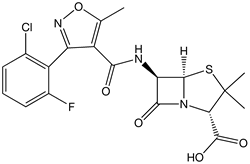I would like to present an unusual case, although the theme of apparent denial and rejection of medical advice in this patient will be familiar to most diabetologists. I would like to discuss this patient in the context of an article looking at the psychological aspects of diabetic foot disease (Mudge and Price 2004).
Case history
The patient, a male aged 72, presented with a painful infected ischaemic right first toe (see Figure 1). He had had diabetes for ten years, and regularly attended the diabetes clinic during this time. He had also regularly attended podiatry assessments and had received footcare education. He was known to have both peripheral vascular and coronary artery disease and the podiatrist had detected some sensory neuropathy.
On this occasion his diabetes was poorly controlled but he declined the offer of admission to the hospital. He was started on oral penicillin V (500 mg qds) and flucloxacillin (500 mg qds), and his Mixtard 30 bd was increased by the diabetes specialist nurse. The wound care department supervised his dressings with the help of district nurses. Despite these measures wound healing was very poor.
A few weeks later he presented with severe maceration (see Figure 2) and now accepted the offer of admission.
When questioned about the appearance of his toe he explained that he had been concerned that the wound dressing was soiling his bed linen. He had solved this problem by taking off the dressing before retiring and replacing it with a condom over his toe. He fixed the condom onto his toe with tape, and took it off in the morning, before reapplying the dressing.
After admission, he had intravenous cefuroxime (750 mg tds) and metronidazole (400 mg tds) and showed much improved diabetes control. Unfortunately, though, his toe became necrotic and painful, and he subsequently had a right trans-metatarsal amputation.
Discussion
This patient's foot condition was primarily due to vascular disease, but his neuropathy may have reduced his awareness of pain. The natural history of his foot disease may not have been altered if he had been admitted when originally invited but it is possible that the extent of the amputation may have been reduced (Munro et al, 2003; Campbell, 2001). Despite being aware of the seriousness of foot problems, the patient had been slow to seek help and had declined advised treatment. He did not demonstrate clinical evidence of cognitive impairment (Cosway et al, 2001).
[FIGURE 1 OMITTED]
Before reading Mudge and Price's article I had thought that this patient was an eccentric who had denied the seriousness of his condition, although I could not understand why he ignored dire prognostications and suggestions which might limit his physical suffering. There could have been several other explanations for his behaviour.
First of all, patient perception of risk does not necessarily correspond with health protective behavior (Cook and Bellis, 2001) and patients can react adversely if advice is contrary to their belief structure (Slovic, 1987)--sometimes with unrealistic optimism (Clarke, 2000). In other words, there is no certainty as to how an individual patient will react to healthcare information. Indeed, verbal persuasion has not been shown to influence patient behaviour (Bandura, 1977).
[FIGURE 2 OMITTED]
The education we gave the patient was of limited value because it was not accompanied by significant behavioural change. We are all trained to be educators, but what we need are successful behavioural change strategies. Motivational interviewing appears to be a more interactive process than education, and it is more successful at achieving behavioural change (Doherty and Roberts, 2002). Motivational interviewing requires acceptance of the patient's agenda as well incorporating the interviewer's educational aims. For example, a patient may know he or she should give up smoking for health reasons but cannot because it gives him or her great pleasure. The interviewer must then work in partnership in a non-judgemental and empathetic manner. Determination and action are the endpoints with permenent lifestyle change achieved, but there will be relapses on the journey. In this patient, most of this came too late, but the earlier manifestations of this problem would be familiar to experienced diabetologists and similar patients could be offered better ways of avoiding a largely preventable complication.
Bandura A (1977) Self efficacy: towards a unifying theory of behaviour change. Psychological Review 84: 191-215
Campbell IW (2001) Diabetes mellitus--don't delay treatment. British Journal of Diabetes and Vascular Disease 1: 147-48
Clarke VA, Lovegrove H, Williams A, Machperson M (2000) Unrealistic optimism and the Health Belief Model. Journal of Behavioural Medicine 23(4): 367-76
Cook PA, Bellis MA (2001) Knowing the risk: relationships between risk behaviour and health knowledge. Public Health 115: 54-61
Cosway R, Strachan MW, Dougall A, Frier BM, Deary IJ (2001) Cognitive function and information processing in type 2 diabetes. Diabetic Medicine 18(10): 803-10
Doherty Y, Roberts S (2002) Motivational interviewing in diabetes practice. Diabetic Medicine 19 (Suppl 3): 1-6
Mudge E, Price P (2004) Risk of diabetic foot ulceration: perception and behavioural change. The Diabetic Foot 7: 95-101
Munro N et al (2003) Infections in the diabetic foot. British Journal of Diabetes and Vascular Disease. 3: 132-26
Slovic P (1987) Perception of risk. Science 236: 280-85
Dai Thomas is a Consultant Diabetologist, Mount Vernon Hospital, Middlesesx
COPYRIGHT 2004 S.B. Communications
COPYRIGHT 2005 Gale Group



